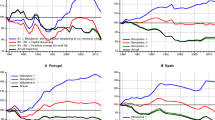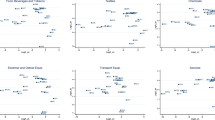Abstract
This paper analyses the determinants of labour productivity in the European Union (EU) area and examines the extent to which convergence in output per worker is occurring among Member States (plus Norway) using a recursive common trends analysis and non-parametric kernel density methods. Data Envelopment Analysis (DEA) is used to construct the best practice EU production frontier and compute a Malmquist index of total factor productivity (TFP) and its decomposition to the factors that affect productivity for each country. We consider a pent-partite decomposition of the growth in labour productivity in terms of (i) pure technological change (ii) input biased technical change (iii) efficiency change (iv) growth in human capital and (v) (physical) capital accumulation. This decomposition enables us to gain more insight on patterns of productivity growth for a cross section of countries as well as isolate the individual factor contributions to (or lack of) convergence and common trends for output per worker in the EU area. The use of human capital as an additional input in the description of technology has a small effect in the overall productivity measures but leads to a substantial fall in the contribution of capital accumulation to growth in output per worker for our sample of countries. Furthermore, there is evidence to suggest that the market reforms of the post 1980 period are likely to have induced considerable change in input prices and factor mix which in turn is reflected in input bias. This is evident from the pattern of the shift in the frontier of technology over time and the underlying trends in the components of technological change. Cross section regression analysis suggests that although there appears to be overall convergence in output per worker in the sample of countries, the input bias component of technological change is a source of divergence. Evidence on increasing convergence among the EU countries is also provided via an analysis of the distribution dynamics of output per worker. Non-parametric methods are used to determine the number of modes in the productivity distribution over time. The evidence suggests that the distribution of output per worker in the EU area has changed from bimodal (twin-peak) to unimodal over time. A recursive common stochastic trends analysis provides further evidence of increased convergence in output per worker among groups (convergence ‘clubs’) of European countries. In particular, the recursive tests show that a common stochastic trend was driving output per worker for the group of small northern European economies (Belgium, Denmark, Luxembourg, Netherlands and Sweden) by the 1990s. Similarly, increased convergence trends were detected for two more groups (1) Greece, Ireland and Portugal and (2) France, Germany and the UK. However, time series tests fail to support the hypothesis that the EU area is a single convergence club.
Similar content being viewed by others
References
Barro RJ, Lee J-W (2000) International data on educational attainment: updates and implications. Center for International Development Working Paper 42, Cambridge, MA.
RJ Barro X Sala-I-Martin (1995) Economic growth McGraw-Hill New York
WJ Baumol RR Nelson EN Wolff (1994) Convergence in productivity: cross national studies and historical evidence Oxford University Press New York
AB Bernard SN Durlauf (1996) ArticleTitleInterpreting tests for the convergence hypothesis J. Econometrics 91 161–173 Occurrence Handle10.1016/0304-4076(94)01699-2
AB Bernard SN Durlauf (1995) ArticleTitleConvergence in international output J. Appl. Econometrics 10 97–108
AB Bernard CI Jones (1996) ArticleTitleProductivity across industries and countries: time series theory and evidence Rev. Eco. Statist. 78 135–146 Occurrence Handle10.2307/2109853
M Bianchi (1997) ArticleTitleTesting for convergence: evidence from non-parametric multimodality tests J. Appl. Econometrics 12 393–409 Occurrence Handle10.1002/(SICI)1099-1255(199707)12:4<393::AID-JAE447>3.0.CO;2-J
Caselli F, Coleman II WJ (2003) The world technology frontier. unpublished paper, Harvard University.
D Caves L. Christensen WE Diewert (1982) ArticleTitleThe economic theory of index numbers and the measurement of input, output and productivity Econometrica 50 1390–1414 Occurrence Handle10.2307/1913388
Chapple S (1994) Searching for the Heffalump? An exploration into sectoral growth and productivity in new zealand. New Zealand Institute of Economic Research Working Paper 94/10.
A Charnes WW Cooper E Rhodes (1978) ArticleTitleMeasuring the efficiency of decision making units Eur. J. Operat. Res. 2 429–444 Occurrence Handle10.1016/0377-2217(78)90138-8
Chaudhuri P, Marron JS (1997) SiZer for exploration of structures in curves. North Carolina Institute of Statistics Mimeo Series #2355.
N Crafts M O’Mahoney (2001) ArticleTitleA perspective on UK productivity performance Fiscal Stud 22 IssueID3 271–306 Occurrence Handle10.1111/j.1475-5890.2001.tb00043.x
S Dowrick D Nguyen (1989) ArticleTitleOECD comparative economic growth 1950–85: catch up and convergence Am. Econ. Rev. 79 IssueID5 1010–1030
Durlauf SN (2000) Econometric analysis of the study of economic growth: a sceptical perspective. mimeo, Department of Economics, University of Wisconsin.
Durlauf SN, Quah DT (1998) The new empirics of economic growth. NBER Working Paper Series 6422. In: Handbook of Macroeconomics. Taylor J, Woodford M (eds.) North Holland, Amsterdam, forthcoming.
R Färe (1988) Fundamentals of production theory Springer-Verlag Heidelberg
R Färe S Grosskopf (1996) Intertemporal production frontiers: with dynamic DEA Kluwer Academic Publishers Boston
Färe R, Grosskopf S, Lindgren B, Roos P (1989) Productivity developments in swedish hospitals: a malmquist output index approach. In: Data envelopment analysis: theory, methodology and applications. Charnes A, Cooper WW, Lewin A, Seiford L (eds.) Quorum Books.
R Färe S Grosskopf D Margaritis (2004) Cross-country comparisons of sectoral productivity performance and the role of policy: a study of OECD countries University of Queensland Brisbane
R Färe S Grosskopf M Norris Z Zhang (1994) ArticleTitleProductivity growth, technical progress, and efficiency change in industrialized countries Am. Econ. Rev. 84 IssueID1 66–83
MJ Farrell (1957) ArticleTitleThe measurement of productive efficiency J. Roy. Statist. Soc. A 120 IssueIDPart 3 253–281
M Friedman (1992) ArticleTitleDo old fallacies ever die? J. Econ. Literature 30 2129–2132
AG Haldane SG Hall (1991) ArticleTitleSterling’s relationship with the dollar and the deutschemark: 1976–1989 Econ. J. 101 436–443 Occurrence Handle10.2307/2233550
RE Hall CI Jones (1999) ArticleTitleWhy do some countries produce so much more output per worker than others? Quart J. Econ. 114 83–116 Occurrence Handle10.1162/003355399555954
SG Hall D Robertson MR Wickens (1997) ArticleTitleMeasuring economic convergence Int. J. Financial Econ. 2 131–143 Occurrence Handle10.1002/(SICI)1099-1158(199704)2:2<131::AID-IJFE42>3.0.CO;2-M
H Hansen S Johansen (1999) ArticleTitleSome tests for parameter constancy in cointegrated VAR-Models Econometrics J. 2 306–333 Occurrence Handle10.1111/1368-423X.00035
DJ Henderson RR Russell (2001) Human Capital and Convergence: A Production Function-Frontier Approach University of California Riverside
DJ Henderson PK Attar RR Russell (2002) Modality tests for use in applied econometrics: application to macroeconomic convergence University of California Riverside
B Hobijn PH Franses (2000) ArticleTitleAsymptotically perfect and relative convergence of productivity J. Appl. Econometrics 15 59–81 Occurrence Handle10.1002/(SICI)1099-1255(200001/02)15:1<59::AID-JAE544>3.0.CO;2-1
PT Hultberg MI Nadiri RC Sickles (1999) ArticleTitleAn international comparison of technology adoption and efficiency: a dynamic panel model Annals d’Economie et de Statistique 55–56 449–474
S Johansen (1988) ArticleTitleStatistical analysis of cointegration vectors J. Econom. Dynamics Control 12 231–254 Occurrence Handle10.1016/0165-1889(88)90041-3
S Johansen (1991) ArticleTitleEstimation and hypothesis testing of cointegration vectors in Gaussian vector autoregressive models Econometrica 59 1511–1580 Occurrence Handle10.2307/2938278
CI Jones (1997) ArticleTitleOn the evolution of the world income distribution J. Econ. Perspect. 11 IssueID3 19–36
S Kumar RR Russell (2002) ArticleTitleTechnological change, technological catch-up, and capital deepening: relative contributions to growth and convergence Am. Econ. Rev. 92 IssueID3 527–548 Occurrence Handle10.1257/00028280260136381
D Kwiatkowski PCB Phillips P Schmidt Y Shin (1992) ArticleTitleTesting the null hypothesis of stationarity against the alternative of a unit root J. Econometrics 54 159–178 Occurrence Handle10.1016/0304-4076(92)90104-Y
S Malmquist (1953) ArticleTitleIndex numbers and indifference curves Trabajos de Estatistica 4 IssueID1 209–242
J Maudos JM Pastor L Serrano (2000) ArticleTitleConvergence in OECD countries: technical change, efficiency and productivity Appl. Econ. 32 757–765 Occurrence Handle10.1080/000368400322381
M O’Mahoney (2002) ArticleTitleProductivity and convergence in the EU Nat. Instit. Econ. Rev. 180 IssueIDApril 72–82 Occurrence Handle10.1177/002795010218000109
SJ Prais (1995) Productivity, Education and training – an international perspective Cambridge University Press Cambridge
D Quah (1993) ArticleTitleGalton’s fallacy and tests of the convergence hypothesis Scand. J. Econ. 95 IssueID4 424–443
D Quah (1996) ArticleTitleTwin peaks: growth and convergence in models of distribution dynamics Econ. J. 106 1045–1055 Occurrence Handle10.2307/2235377
D Quah (1997) ArticleTitleEmpirics for growth and distribution: stratification, polarization, and convergence clubs J. Econ. Growth 2 27–59 Occurrence Handle10.1023/A:1009781613339
J Rangvid (2001) ArticleTitleIncreasing convergence among European stock markets? A recursive common stochastic trends analysis Econ. Lett. 71 383–389 Occurrence Handle10.1016/S0165-1765(01)00361-5
Rangvid J, Sorensen C (2001) Convergence in the ERM and declining numbers of common stochastic trends. Unpublished Paper, Copenhagen Business School.
Scarpetta S, Hemmings P, Tressel T, Woo J (2002) The role of policy and institutions for productivity and firm dynamics: evidence from micro and industry data. OECD Working Paper No. 329.
RW Shephard (1970) Theory of cost and production functions Princeton University Press Princeton, NJ
Author information
Authors and Affiliations
Corresponding author
Additional information
Earlier versions of this paper were presented at the 2002 Australasian Macroeconomics Workshop in Wellington and the 2003 Hellenic Workshop on Productivity and Efficiency Measurement in Patras. We would like to thank participants at both workshops for helpful comments. We would also like to thank the Journal editors and referees for their comments and encouragement and Gary Feng for valuable research assistance.
Rights and permissions
About this article
Cite this article
Färe, R., Grosskopf, S. & Margaritis, D. Productivity Growth and Convergence in the European Union. J Prod Anal 25, 111–141 (2006). https://doi.org/10.1007/s11123-006-7134-x
Issue Date:
DOI: https://doi.org/10.1007/s11123-006-7134-x




